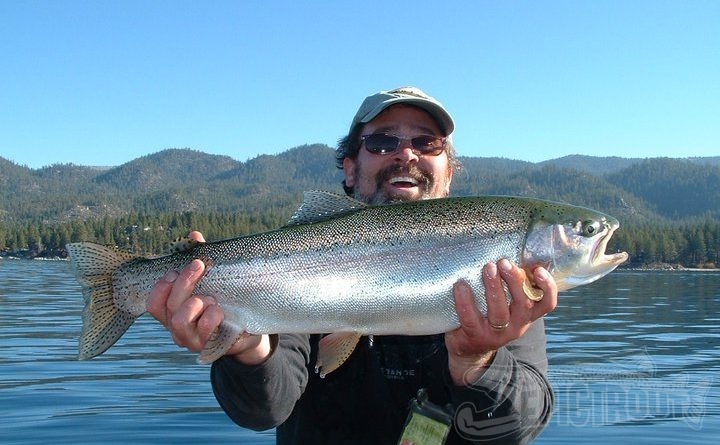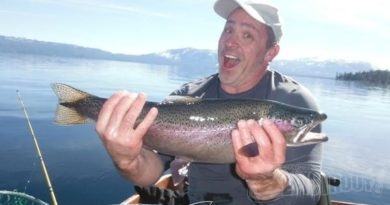Flashers How to…
No, I’m not talking about perverts charged with indecent exposure. Here in northern California, flashers are simply a type of fishing tackle quite popular with trout trollers, because like those trenchcoat wearing deviants that share the name, they will deliver the goods.
If you’ve ever used spinnerbaits for bass fishing or in-line spinners such as Rooster Tails, Mepps, or Panther Martins for casting to trout, you are already familiar with the principal that makes flashers so effective. Also known in the northwest as “trolls”, “blades” and “pop-gear” (after a Mr. Ralph Geer, early developer of flashers in Oregon) these are simply lengths of steel wire or cable, with a metal or plastic keel at the head, to prevent line twist. Swivels are attached to each end, for securing the main line and terminal leader. At fixed intervals, cupped pieces of metal, “the blades”, are attached (through a clevis or in-line through a hole in the blade), rotating around the fixed base, turned by water pressure during a troll or retrieve in the same way the vanes of a windmill turn in the wind. The blades typically sport a shiny metallic finish, and create a minnow imitating, fish-attracting flash as they turn and catch the light.
What sets flashers apart from other spinning-blade lures, though, is that they are purely trolling attractors. With no hook to catch the fish, these devices must have a length of leader and a lure or bait with hook attached to do their job. This combination requires a lot more thought (not to mention knots) than spinning lures, but the effort is worthwhile. I troll flashers extensively each year to catch mackinaw at Fallen Leaf Lake, rainbow trout on Tahoe, and brookies at Caples. Let’s examine some of the effective rigging and trolling techniques that often make my “jewelry box” the first thing I pull out of my tackle bag for a morning’s fishing.
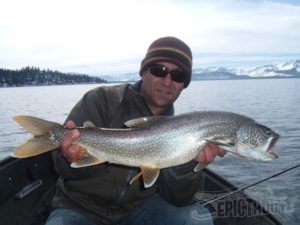

Choose your weapon: Like a trophy wife selecting a necklace at the diamond emporium, your choice among the various styles and brands of flashers is highly personal, subject to whim. If one particular model sparkles on the shelf and hypnotizes you, buy it and try it. Just consider that no single shape, color or size of flasher can cover every situation, and fish accordingly. Here’s a guide.

Shape and size: The bigger they are, the harder they pull. I know local anglers who do well with Luhr Jensen’s appropriately named “Ford Fenders” in the largest sizes, but large, water resistant flashers perform poorly at any more than the slowest trolling speeds, creating so much resistance that they put undo stress on the rod and line, not to mention the fisherman as he tries to reel in. Even worse, the powerful, pulsating pull of large flashers on your line masks both the initial hit and subsequent fight of all but the largest fish; I once trolled a 17 inch mackinaw around Fallen Leaf Lake for half an hour on a heavy rod, thinking that the barely noticeable extra kick in my rod tip was just a flasher blade that was jammed and not turning smoothly.
The traditional argument for large flashers is that they perform well in deep water, where their increased size creates more fish-attracting flash in the limited light. This may be true, but while testing the theory several years ago, I became so annoyed with the loss of light-tackle fun as I coupled large flashers with downriggers or lead core line and heavy trolling weights that I switched to smaller, lighter attractor blades. This not only increased my enjoyment, but my catch as well- I was able to detect subtle bites, small fish and bottom-bumps much more effectively. Likewise, I have been experimenting with smaller and lighter flashers for shallow water applications, and the results continually teach me new and varied applications for my “necklaces”.
The shape of your flasher’s blades is as important as their size, and has the same effect, that of increasing or decreasing the water resistance and pull on your rod as you troll. I normally choose one of three popular blade shapes:

Colorado: Oval and cupped, like a wide serving spoon, this is a good shape to start with while learning to use flashers. My favorite in this style is the “Sep’s Pro Flashers” line, which combines ultralight features such as small blades, swivels, and light steel cable with quality construction. Medium resistance; good for slow (less than one mph) to medium trolling speeds. My “large” Sep’s Colorado blade flashers will troll unweighted at just under 25 feet on a long (50+ yards), unweighted 8 -12 pound line. With weight or off downriggers, coupled with a live minnow or Flatfish lure, they are my favorite choice for deep trolling Fallen Leaf Mackinaw.

Willow Leaf:These slimmer blades are oblong, with curved sides leading to a point, or V at each end. Less water resistance actually means that higher trolling speeds are required to achieve the best action, and the streamlined profile will cause less of the line twist that plagues wider-bladed flashers at high speeds. My Sep’s medium willow leaf flashers will troll well to over two mph, running only 18 – 20 feet deep unweighted on long, light line. This rig, with a three foot leader and live minnow, has been excellent for wild rainbow trout on Lake Tahoe this fall.
Beer Can: A variation of the Colorado style, this is a wide blade as well, with some unique characteristics. Instead of a cupped lip, the entire blade is curved, with a pear or teardrop shape, like the old pull-tab pop-tops those of you over forty years old might remember finding on soda and beer cans in your youth (thus the name). My favorite brand is the classic “Cousin Carl’s Half-Fast Flashers” (say Half-Fast five times fast). These are mounted in-line, through a hole in the blade, and with only two blades, produce a special, off-beat action that can produce fish when other flashers fail.
Three and four blade Colorado or willow leaf flashers produce a rapid, heartbeat-pulse in the rod tip, each blade contributing to a rhythmic “hum” that essentially remains unchanged once you establish a constant trolling speed.
The blades on my beer-can flashers, though, produce the most water-resistance of all (I use them only in the smaller sizes), and work best at slow trolling speeds, which bring out their “secret magic”. The two blades turn independently, each giving a small pulse to your rod on every revolution. Every few turns, though, the blades chance to line up for a turn, both moving through the same portion of the circle they scribe at the same time. This produces a “double-strength” pull for a moment, as the resistance of both blades is at maximum, before one blade speeds up or slows down just enough to fall back out of sync with its partner. To the uninitiated, that extra surge in the rod tip will look like a strike from a fish, but once you learn to recognize this “bonus action” for what it is, you will come to appreciate the number of fish attracted by the irregular movement this blade style imparts to your bait or lure. A small Cousin Carl, followed by a Rebel Crayfish wobbling plug, has produced excellent catches for me from Blue Lakes, Caples, and Silver Lake, where I’ve found fish from 10 inch rainbows to ten pound mackinaw drawn to the irresistible flash and wobble of this combination.
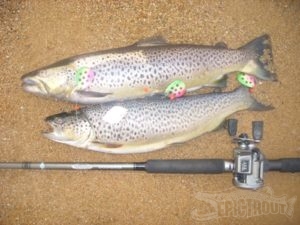
Color: Silver is my first choice for clear area lakes and sunny conditions, with gold a good backup for murky waters and overcast conditions. Either color benefits from the addition of prism/holographic reflector tape, and both Sep’s and Cousin Carl’s make models with such tape attached. These brands also have a high quality finish that maintains its shine over time with little care or polishing, which is important. I have found that the Luhr Jensen and Pop-Geer line of flashers tarnish and develop discoloration in their finish rather quickly. They also both feature pink or red, translucent plastic keels, which I do not like at all. Not only do they do little to add to the attraction factor of the flashers, they are a weak point in the rigging. I have seen the plastic, which is all that connects the flashers to your line, crack and break. Look for a metal keel, in a color to complement or contrast with the flasher blades.
Trolling techniques: All flashers should be trolled at slow to medium speeds, with the willow leaf style performing best at the top end. Start with your set in the water at boatside, at a speed just fast enough to turn the blades. You’ll be surprised how little forward motion this takes- some gas motors simply cannot be run slow enough to effectively troll flashers. An electric motor is often a better choice.
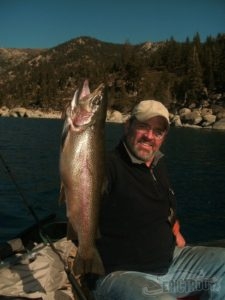
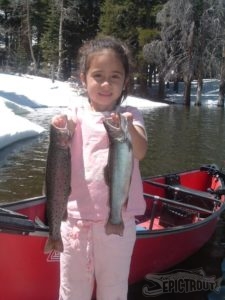
Once you have established a speed that imparts the correct, sexy action to your flashers, look at and memorize the “wocka-wocka” movement transmitted by the pulsing blades to your rod tip. When topline trolling without downriggers or lead weights, this will be the baseline against which you judge the action of a properly running rig against bottom bumps, light hits, and fouling by weeds. If you don’t know how the flashers affect your rod, you will constantly mistake their effect for “something going on down there”.
The running depth of unweighted flashers is a unique function of the combination of three factors. Only experience trolling them, preferably with a depthfinder, will give you an accurate “feel” for each rig’s capabilities, but here are the variables to consider. Size and weight- the larger and heavier the blades, the deeper they will sink on a troll. The wider blades with more water resistance will ride higher per size/weight than slimmer, more compact blades. Speed- the faster you troll, the more shallow the flashers will run. I will speed up my motor to pull my flashers upward when I am close to bumping bottom, and will slow down to allow them to dig deeper when passing over a deep hole or drop-off. The number one mistake I see most flasher-trollers make is moving too fast. Line length and size: Up to 150 yards or so, the more line you let out, the deeper your flashers will run. I can troll a given set of blades at less than 20 feet deep with less than 50 yards of line out, then let out line until the same flashers are over 100 yards behind the boat, where they reach over 25 feet. Line diameter also affects depth. Expect to run 5 feet deeper on eight pound line (through less water resistance against the thinner line diameter) than on fifteen or twenty pound. I like to use a combination of line length/thickness, speed, and size/weight of flashers to troll effectively, tight to the bottom, while avoiding the second most common mistake among flasher users, trolling too short a line.
I’m always amazed by the number of trollers I see on area lakes who run their flashers practically in the wake of the boat. This is usually because they have only one set of flashers, in one size, LARGE. When the flashers are big and heavy enough to hang up on the lake bottom in thirty-five feet of water, anglers often compensate by running a short line, which keeps the blades shallow, preventing them from losing their gear. This also prevents many hook-ups, though, as wary fish are put off by the closeness of the boat, and fish near the bottom are not willing to move long distances to chase a lure near the surface. Instead of running one large set, try experimenting with smaller, lighter flashers. Once you learn their trolling depths, you can select a set that you can fish slowly right near the bottom, where the fish are, on a long enough line to ensure stealth. If I want to run 25 or 30 feet deep, I can tie on my Sep’s large Colorado blades and run a long line, while with my Sep’s “Micro-Mini” flashers, I can troll in as shallow as 10 to 12 feet, on a slightly shorter line. While an electronic depthfinder is not essential for flasher trolling, it allows for a much more accurate presentation, and most trout, whether deep or shallow, come to your flashers not when they trolled are in open water, far from the bottom or shoreline structure, but when they come within a few yards of fish holding rocks, shelves or underwater points.
Bait and Lures: Let’s say you’ve followed my advice to this point, and using your sonar unit and the correct set of flashers, you have lined up for a perfect troll along that steep, fish-holding drop-off at your favorite lake. Reel back in now, stupid, because we forgot to tie anything with a hook behind your attractor blades. Bait is the first and best choice; a nightcrawler in most lakes or a minnow where permitted. Either should be threaded onto a two or three foot leader (use a worm threader for nightcrawlers, a large sewing or bait threading needle for minnows), followed by a single baitholder hook for worms or a treble hook for minnows. Worms must be trolled at the lowest speeds only, or they will bunch up on the hook from water resistance. Minnows can be pulled faster- they start to spin at higher speeds, but this only seems to add to their fish-drawing ability.
Lures also work well behind flashers, with the only real limitation being speed. The lure must work well at low speeds to be coupled effectively with them. Large minnow plugs, such as #13 and #18 Rapalas, are not a good choice, since they need medium fast trolling speeds, 2 to 3 mph or more, to bring out their wounded-minnow wobble. I often use small floating and jointed Rapalas (#5 – #9) with flashers, though, since these wobble correctly at lower speeds. A trolling spoon such as the Needlefish or Krokodile is another popular choice, but my personal favorite artificial lure for flasher trolling is a wide-wobbling plug. Flatfish, Kwikfish and the Rebel Crayfish are all effective, with body shapes and action designed for slow speeds. This summer, try the Rebel behind a Cousin Carl for a three-species day on Caples or Silver Lake, or a huge, T-55 Flatfish in pearl, behind Sep’s Colorado blades, for trophy Fallen Leaf Lake mackinaw. Can’t wait? Right now, Lake Tahoe is producing quality fish on toplined and downrigged flashers with minnows, and on just about any high sierra lake, great fishing for planter and holdover trout is waiting for trollers who know that “blades-and-crawlers” is not the name of a new heavy-metal band.

